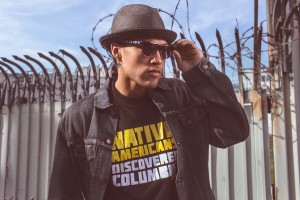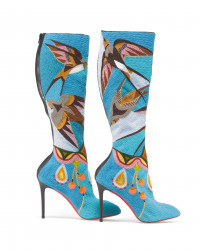

On Tuesday June 7, 2016, Joseph Gallivan interviews clothing designer Jared Yazzie about the show Native Fashion Now, which runs through Sept. 4 at the Portland Art Museum.
Yazzie will talk about the emergence of native fashion from open air markets to Project Runway and haute couture. His own brand OxDx grew out of graphic design, street art and punk, both on and off the Navajo reservation in Arizona. He will discuss authenticity, “collabbing” and appropriation, and the new energy Instagram, Twitter and Facebook have brought to the Native peoples and their artwork.
This show is edited by KBOO volunteer Sam Parrish.
See designs here http://shop.beyondbuckskin.com/artist/jared-yazzie-navajo-for-oxdx
From the press release:
Native Fashion Now
JUN 4 – SEP 4, 2016
Download the exhibition announcement
The Portland Art Museum is pleased to present Native Fashion Now, the first large-scale traveling exhibition of contemporary Native American fashion, celebrating indigenous designers from across the United States and Canada, from the 1950s to today. Organized by the Peabody Essex Museum in Salem, Mass., Native Fashion Now opens at the Portland Art Museum on June 4, 2016.
From vibrant street clothing to exquisite haute couture, this exhibition celebrates the visual range, creative expression and political nuance of Native American fashion. Nearly 100 works spanning the last 50 years explore the vitality of Native fashion designers and artists, from pioneering Native style-makers to today’s maverick designers making their mark in today’s world of fashion.
Featuring contemporary garments, accessories and footwear spanning a variety of genres and materials, these designers traverse cross-cultural boundaries between creative expressions and cultural borrowing. From one of Patricia Michaels’ (Taos Pueblo) recent finale ensembles from the reality television series Project Runway to Jamie Okuma’s (Luiseño/Shoshone-Bannock) dramatically beaded Christian Louboutin boots and innovative works made from mylar, vinyl and stainless steel,Native Fashion Now underscores Native concepts of dress and beauty, which are inextricably bound to identity and tradition in a rapidly changing world.
60 Years of Native Fashion
Native Fashion Now examines four themes—Pathbreakers, Revisitors, Activators and Provocateurs—reflecting how designers respond to ideas and trends in the world of Native fashion. Pathbreakers are groundbreaking designers, while Revisitors refresh, renew and expand on tradition. Activators embrace an everyday, personal style that engages with today’s trends and politics, while Provocateurs depart from conventional fashion to make works that are conceptually driven and experimental. All of these designers have something important in common: through their work, they express artistic agency, cultural identity and their unique personal perspective. Native Fashion Nowinvites the public into a dynamic, contemporary fashion scene and offers the opportunity to explore both its roots and its cutting-edge, new paths. Runway footage, artist interviews and fashion photography communicate its immediacy throughout the exhibition.
In the middle of the 20th century, Native artists began to reach beyond their own communities, and entered the world of mainstream fashion. The Cherokee designer Lloyd “Kiva” New was the first to create a successful high-fashion brand. In the 1950s, he sold his customized clothing and accessories to a specialized clientele across the nation, from boutiques on Fifth Avenue to Beverly Hills, and distributed his line through Neiman Marcus. Since New’s days as a pioneering Native designer, many others have brought his entrepreneurial, innovative spirit into fashion design and Native aesthetics. They source their fabrics globally and bring their designs to wide markets, achieve recognition far beyond their home communities and create fashion that blends cultural iconography and knowledge with mainstream design.
Jeweler and metalsmith Pat Pruitt (Laguna Pueblo) trained as a mechanical engineer. He worked in machine shops and in the body piercing industry before starting to make jewelry in the mid 1990s. His materials are radically different from the familiar turquoise and silver of the Native American Southwest. Employing non-precious metals like titanium, stainless steel and zirconium, Pruitt uses computer-aided technology alongside classic jeweler’s tools. Driven by his passion for personal adornment, and deeply involved in his Pueblo community, Pruitt is an active agent of change in a market where objects are too often valued primarily for their conformity with the expected aesthetics of the Southwest.
About a decade ago, New York fashion powerhouse Donna Karan metVirgil Ortiz (Cochiti Pueblo) at Santa Fe’s Indian Market. She fell in love with Ortiz’ ceramics, made in the style developed by his ancestors centuries ago: sinuous geometric patterns in black set against ivory backgrounds. An internship with Donna Karan led Ortiz to collaborate on the Donna Karan Spring/Summer 2003 line, marrying her signature silhouettes and fabrics with Pueblo patterns. Since then, Ortiz has launched his own fashion line, VO, producing everything from lasercut leather jackets, pants and handbags, to cotton T-shirts and silk scarves, all “Made in Native America,” as his tagline proclaims.
Jamie Okuma (Luiseño/Shoshone-Bannock) began beading at the age of 5, and at 22 became the youngest winner of Santa Fe Indian Market’s prestigious grand prize. For her recent work Okuma spent hundreds of hours hand-stitching antique 1880s beads onto a pair of Christian Louboutin boots, repurposing them to make something beautiful that is her own. By the time she was finished, only the boots’ famous red soles remained exposed – the rest of the surfaces were covered with her stylized and bold beadwork designs inspired by motifs common to Western tribal communities.
Although fashion as a means of self-representation is a recurring theme in Native Fashion Now, it’s perhaps most obvious in streetwear. Jared Yazzie (Diné [Navajo]) boldly re-claims America as indigenous country in his “Native Americans Discovered Columbus” T-shirt, reminding us that the so-called New World had a population in the millions when the explorer “discovered” it in 1492. For Yazzie, words are weapons that can encourage people to think harder about the truths of history, and T-shirts are an affordable, bold outlet for expressing opinions and flaunting individuality.
Native Style in the Pacific Northwest
Native Fashion Now includes the work of a number of Native artists who draw on their Pacific Northwest tribal cultures. Dorothy Grant (Haida) was among the first Natives in the region to brand and sell clothing inspired by their tribes’ ceremonial garments, and she has continued to produce compelling ready-to-wear and couture clothing over the past 25 years. Vancouver, B.C.-based artist Alano Edzerza (Tahltan) uses the formline style of Northwest Coast indigenous art in work such as hisChilkat tunic (2013), while Seattle shoe designer and cultural identity advocate Louie Gong (Nooksack, Squamish, Chinese, French, Scottish) merges art and activism in his customized, hand-decorated sneakers.
The exhibition includes work by Northwest Native artists who will be familiar to Portland Art Museum visitors from other exhibitions and the Museum’s excellent and growing permanent collection of Native American art. Portland multidisciplinary artist Wendy Red Star’s work is featured in this spring’s special exhibition Contemporary Native Photographers and the Edward Curtis Legacy. The Museum has loaned her provocative 2013 work síkahpoyíí / bishée / baleiíttaashtee (Motor Oil Buffalo Dress) for the traveling exhibition of Native Fashion Now, and another of her recently acquired works of wearable art will be displayed in the permanent galleries this summer. Meanwhile, Tlingit/Aleut artistNicholas Galanin will have work on view at the Museum not only inNative Fashion Now, but also in a video installation opening in May in the Jubitz Center for Modern and Contemporary Art, as well as in the Museum’s permanent Native American Art collection.
The Museum is organizing a variety of related public programs in conjunction with Native Fashion Now. For more information and updates, please visit portlandartmuseum.org.
Native Fashion Now is organized by the Peabody Essex Museum and host curated by Deana Dartt, Ph.D., Curator of Native American Art.
SPONSORS:
Lead Sponsors: Native American Art Council of the Portland Art Museum in honor of Deana Dartt, Ginny and Bill Allen, Robert and Julia Ball, Byron and Susan Henry, P. Janesh, PH.D., Barbara Kim, Barbara Kommer and Kurt Koenig, Dave and Liz Lambert, Betty Lavis and Charles Brasher, David and Connie Manning, Kathleen Marquart, Donna J. and Donald A. Osborne Jr., Patricia Prado, Eva Rickles, Mary and Gene Sayler, Karen M. Schmirler, Barbara Schramm, Wayne Schweinfest, Barbara G. Van Raalte, Sabine Wild, Molly Cliff Hilts and David Hilts, James and Carol Zuiches, Anonymous; Major Sponsor: Nani S. Warren / The Swigert Warren Foundation; Presenting Sponsor: Exhibition Series Sponsors; Sponsors: Laura S. Meier, Santa Fe Natural Tobacco Foundation, Rose E. Tucker Charitable Trust, Wells Fargo, Leona and Pat Green, Confederated Tribes of Grand Ronde, Angela and Rex Snow, The Honorable and Mrs. William P. McCormick, Pendleton Woolen Mills, Confederated Tribes of Siletz Indians, Anonymous; Education Sponsor:Selby and Doug Key.
- KBOO


